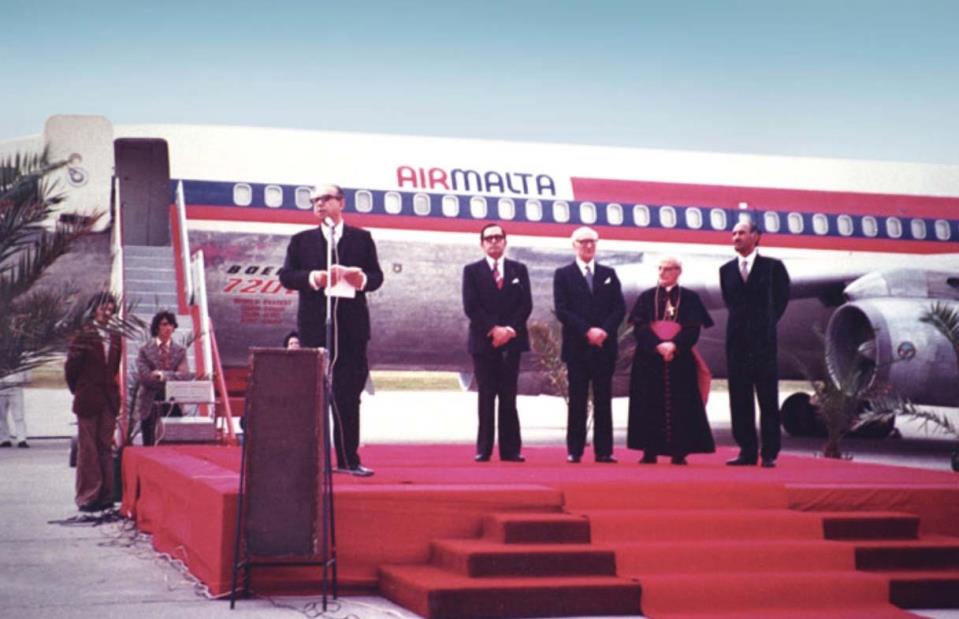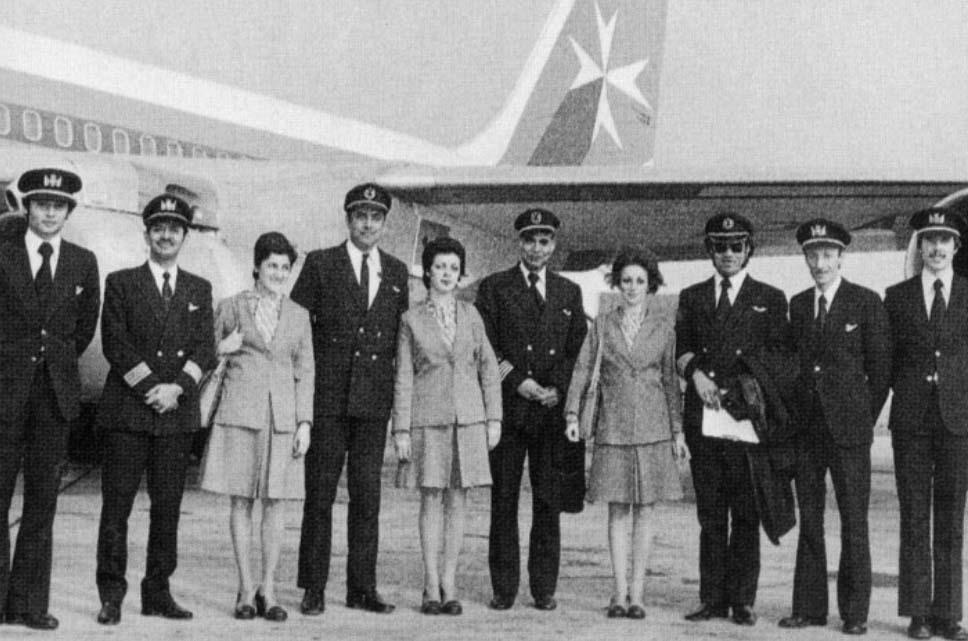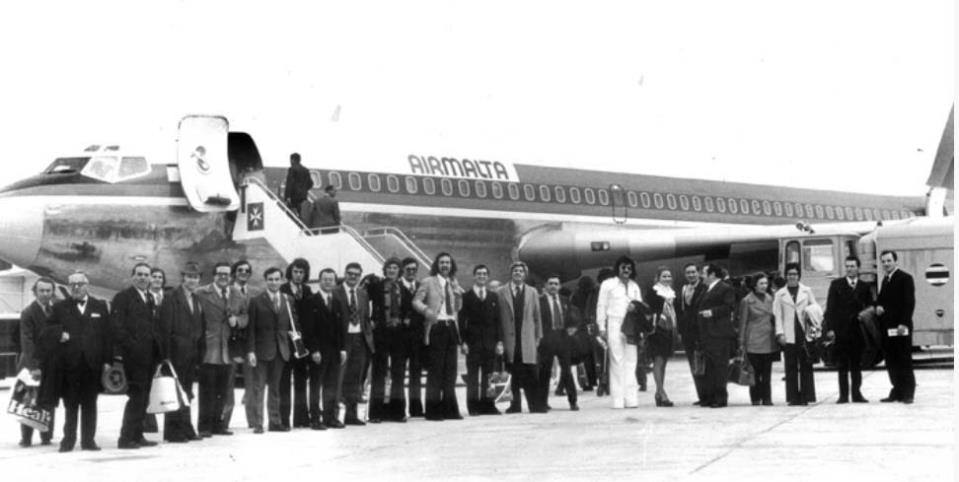After having launched its first flight 50 years ago, Air Malta yesterday closed its doors due to financial troubles, and is being replaced by KM Malta Airlines, which will operate its first flights today.
Air Malta was set up by a parliamentary resolution on 21 March 1973. The airline began flight operations a year later, on 1 April, 1974.
It was Malta’s most recognised company, and played a crucial role in the steady expansion of the tourism industry. It was also vital in connecting Malta to the rest of the world.
The company’s first executive chairman was Albert Mizzi. Mizzi took over the national airline in its first year, 1973, until 1992, “during which time Air Malta turned record profits and gained its reputation as a reliable and safe airline that means business,” the airline had said.
When it started, the airline used two wet-leased Boeing 720Bs from Pakistan International Airlines, and had scheduled services to London, Birmingham, Manchester, Rome, Frankfurt, Paris and Tripoli. The number of planes grew over the years, as did the number of routes.
It operated a range of different aircraft throughout its lifetime, including three B737-200 Advanced aircraft which the airline had purchased and were delivered in 1983. “Within six months of the purchase, Air Malta set a world record with the highest utilisation for all operators of this aircraft type: 14.9 hours per aircraft per day in September 1983,” Air Malta’s website read.
Some of its memorable moments are undoubtedly when Pope John Paul II flew to Malta on an Air Malta planes in 1990 and 2001, when Pope Benedict XVI flew on the airline in 2010 and when Pope Francis flew to Malta in 2022.

The Deputy Prime Minister, Dr A. Buttigieg, addressing guests present at the inauguration of Air Malta on the 31st March 1974. Looking on from left to right are Albert Mizzi, Chairman of Air Malta, Sir Anthony Mamo, Governor General, Mgr Gonzi, Archbishop of Malta, and Air Marshal Nur Khan, Chairman of PIA.
At a time the company also owned hotels, such as the Selmun Palace Hotel that it held through a subsidiary firm, which was closed in 2011 when the airline restructured operations to focus on aviation business.
At the company’s end, Air Malta had a fleet of 8 Airbus A320 aircraft and flew to 18 scheduled destinations in the Middle East and Europe, the Air Malta website showed. There had been a time when the airline flew to 37 destinations.
“From just 52,000 passengers carried in its first year, the airline now carries 2 million passengers yearly and over the course of its history transported over 56 million passengers safely to and from Malta,” the airline said days before it shut its operations.
But in later years, mostly as a result of bad decisions and over-employment, the company’s financial situation went from bad to worse, until there was no other option but for the government to announce its closure last year.
ADPD had once said that Air Malta was plagued by clientelism. “Successive strategic plans failed because there had not been the political will for Air Malta to operate without political interference. Millions of euros in ‘aid’ have been squandered which effectively financed the clientelism that has led to Air Malta’s downfall,” the party had said.
Finance Minister Clyde Caruana last year said that former politicians from both administrations over the years had "used and abused" Air Malta for their own benefit. Caruana said that a company which was meant to make profit needed responsible decisions to be made. "Had things been done properly, this company would not have to go through this. It was used and abused, and these are the facts at the end of the day," Caruana had said.
A snapshot of the company’s financial situation shown in a presentation in 2022, showing the years 2005 to 2020, had detailed that the company was already in the red in 2005.

The crew of Air Malta’s First Flight. From left: Mario Genovese, PIA pilot, Carmen Fenech Vander Weerden, PIA pilot, RoseMarie Zammit, PIA Pilot, Dorothy Dalli Ulenhaut, PIA pilot, Reggie DeBono and Norman Falzon.
In November 2010, the European Commission authorised a loan facility of €52 million for Air Malta as rescue aid. This was subject to the submission by the Maltese authorities of a restructuring plan within a six-month period, a European Commission press statement at the time had said. “In May 2011, Malta notified the Commission of a €130 million capital increase to help restructure the company, which has been in difficulty for several years. The Commission had a number of doubts whether the notified restructuring plan complied with the requirements of the 2004 EU Rescue and Restructuring Guidelines. Therefore, the Commission opened an in-depth investigation in January 2012.”
The Commission's investigation found that the restructuring plan, covering a period of five years up until November 2015, was “based on realistic assumptions and should enable Air Malta to become viable within a reasonable timescale.” The Commission had said that it was satisfied that the proposed capacity reduction consisting in the withdrawal from certain routes will avoid undue distortions of competition. “Moreover, Air Malta will contribute to the costs of restructuring by selling land and other assets, as well as securing a private bank loan,” the statement back in 2012 read. It had concluded that the €130 million aid amount granted to Air Malta for its restructuring was in line with EU state aid rules.
But even after this, the airline continued to struggle. After the change of government in 2013, the PN had accused the government of failing to implement the 2012 restructuring plan, and had even said that Air Malta folded because the Labour government didn’t follow the plan.
Audited figures announced during Air Malta’s Annual General Meeting showed that the airline posted a loss of €16.2 million for the year ending March 2014, “compared to €31 million registered during the financial year ending March 2013,” a statement by the airline in 2014 read. The chairperson of the airline at the time, Maria Micallef, had said that “the current financial year had been directly hit by the closure of the Libyan routes (losing the airline around €1 million per month, including incremental revenue from transit business) and a 20% increase in seat capacity of other airlines in the peak months.”

The passengers of Air Malta’s first flight to London Heathrow.
But for the 2015 financial year, an Air Malta statement had read that the airline’s audited financials had showed a loss of another €16.4 million.
It was around this time when the government was trying to find a strategic partner for Air Malta.
In 2015, there were reports of talks between Air Malta and Turkish Airlines such an alliance. Reports at the time read that the discussions may have included privatising part or the whole airline, but former Prime Minister Joseph Muscat had said that government had to remain majority shareholder.
Later, there were reports about talks with Alitalia as a possible strategic partner, but it didn’t materialise, with Alitalia also having its own difficulties at the time. The Tourism Minister back then, Edward Zammit Lewis, had said that the government was still committed to finding a strategic partner.
In 2019, when the airline fell under Konrad Mizzi’s portfolio, the announcement was made that Air Malta made a profit in 2018 for the first time in two decades. The profit was of €1.2 million. Minister Mizzi had also mentioned the idea of Air Malta being part of a global hub and spoke of his dream of seeing Air Malta planes on the runways of big international airports, the likes of JFK airport in New York. This never came to fruition.
But the profit seen that year has since been attributed to the sale of assets. In 2022, the airline’s Executive Chairman David Curmi had said that the airline made a profit in two years (2018 and 2019) since 2005, but clearly attributed this profit to the generation of two, one-off, non-recurrent transactions. “These were the sale of the airline’s Heathrow and Gatwick landing rights, and the sale of the Air Malta brand, to a government company,” he said. “This happened so that the company could generate cash to continue operating. If these transactions did not happen, the loss would have been of €17 million in 2018 and €30 million in 2019.”
A few years later, during the Covid pandemic, the airline’s fate was sealed.
Finance Minister Clyde Caruana had announced in 2022 that the airline was going to reduce its staff complement by over 400, which amounts to around half of the personnel. For instance, it introduced a voluntary transfer scheme, to transfer employees out of the company’s administration to other government sectors.
It was part of a last ditch effort to try and save the airline and came while it was holding meetings with the European Commission to try get approval for the injection of funds.
Caruana had said that the company found itself in the position it did as, over the years, instead of attempts to operate the company on commercial lines, political decisions took over from common sense. Those decisions resulted in a loss over the years as well as burdens that Air Malta could have done without, he said. A lot was said about possibly going to the American continent and Asia, the Finance Minister said. “Those plans, for which a set of planes was going to be bought, do not make sense in light of all this.” Those two planes that had to be bought were changed to ones that make more sense for the European continent, he said.
There was one particular issue which Finance Minister Clyde Caruana had slammed the former Nationalist government for introducing: The early retirement schemes for pilots and cabin crew.
In November 2022, the minister tabled collective agreements in Parliament which were signed in 2009 between the airline and cabin crew and in 2012 with pilots. The minister said they were a millstone around the airline's neck. One clause stipulated that pilots who retire from the airline at 55 after a number of years in service will continue to receive two-thirds of their salary until they reach the national pensionable age.
The early retirement schemes resulted in €90 million hanging over Air Malta's head, the minister said last October. Government had been engaged in discussions and negotiations with the Airline Pilots Association Malta (ALPA) and with the Union of Cabin Crew (UCC), to commute, liquidate and terminate the early retirement provisions in the Collective Agreements subject to certain conditions. It was said that pilots and cabin crew members will have up to four years after the new company opens to take up the early retirement schemes. However, pilots taking up the scheme would never be able to work with the national airline or in the public sector again, and cabin crew taking up the scheme wouldn't be able to work within the public sector or with the national airline for six years, he had said.
Talks with the European Commission evidently did not end with the government being able to go through with obtaining permission for Air Malta to be given state aid, and instead a decision was taken to close the airline and for a new national airline to be set up.
During the announcement last October, Prime Minister Robert Abela said that "we are ensuring that Malta will continue to have a national airline (...) One that is stronger, one that makes a profit, and one that serves this country on an economic and social level." Abela and Caruana said that the new company will have the same number of aircraft - eight - that Air Malta had at the time, and that while the number of routes will be reduced, the number of passengers that it will carry will be equivalent to the amount Air Malta carried in 2019.
They had said that €350 million will be injected into the new airline, which was later named KM Malta Airlines. €50 million of this would be working capital, while €300 million would be in the form of assets. They had said that unlike Air Malta, the new company will own three of the aircraft instead of leasing all of them. In terms of other assets, they said that it will purchase back the Heathrow and Gatwick slots that had been transferred to Malta Med Air – a government company – in 2018, and that it would have the hangar in Malta and some land around it. After 30 March 2024, it was said, Air Malta Plc, will start winding down and will eventually be liquidated.
Air Malta flew for the last time yesterday.
As KM Malta Airways launches its first flight today, it marks a new chapter in the country’s aviation history, one without Air Malta, a company that was synonymous with the country’s tourism sector for so many years.